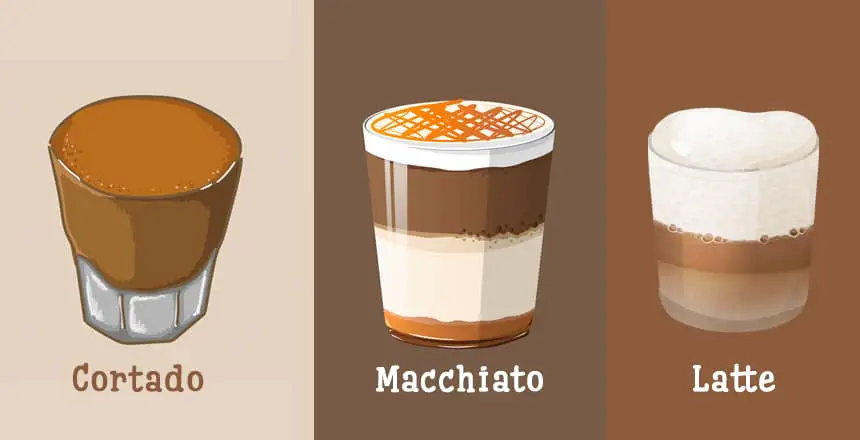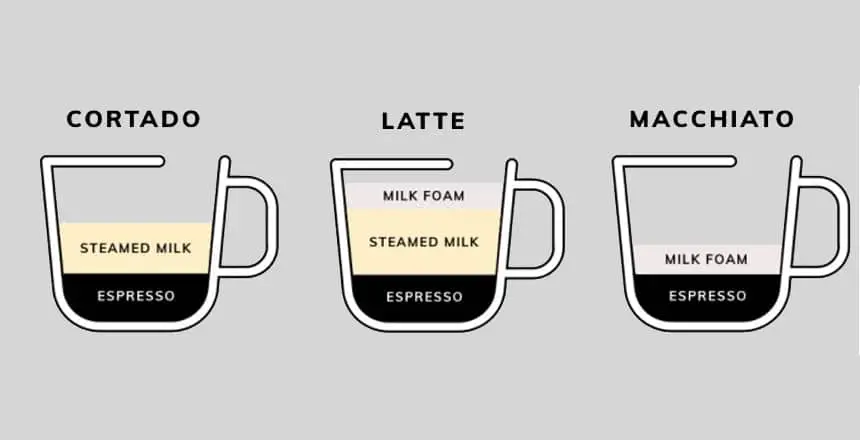Espresso with steamed milk and espresso with foamed milk, both do not produce the same result. There’s a wide range of espresso-based coffee drinks, so which one or ones do you prefer? To have a preference, it’s important to know the differences between these beverages. In this post, I’ll be discussing the comparison of Cortado vs Macchiato vs Latte – all espresso-based drinks a genuine coffee lover can’t get enough of!
There are pretty discernable differences between these three very popular caffeine-infused beverages. The flavor is different, the texture is different, the taste is different, the mouthfeel is different – let’s find out how each drink is prepared and what it contains.
Contents
Cortado vs Macchiato vs Latte – Overview, History, and Cultural Context

Cortado
Originating from and a huge part of the Spanish coffee culture, cortado consists of equal part espresso and equal part steamed milk. “Cortado” comes from the word “cortar” meaning to cut. So the milk cuts through the espresso shot, thus giving rise to a lighter, sweeter taste. The flavor is smooth and well-balanced, without the overpowering bitterness.
A small glass is used for serving a cortado because less milk is added to the coffee drink. And because little milk is added, its milk-to-espresso ratio is not the same as that of a macchiato.
The cortado became really popular in Spain’s Basque Country and from there spread to the rest of Spain and also Spanish-speaking countries all over the world.
Macchiato
What cortado is to the Spanish people, macchiato is to the Italians. It’s a strong-flavored coffee beverage that also contains espresso. But foamed milk is used instead of steamed milk, unlike cortado. The taste and flavor are really potent because only 1–2 teaspoons of milk is added. And sometimes a higher espresso-to-milk ratio is also used.
In Italian, the word “macchiato” means spotted or stained. The traditional version of a macchiato includes very strong espresso and just some milk – the latter is added for softening the intensity of the former.
Latte
A latte is the creamiest of the three and is widely popular in America and Australia. With 20 percent foamed milk, 60 percent steamed milk, and 20 percent espresso, the latte has a comparatively much milder flavor than macchiato and cortado. But it’s this particular taste and texture that makes the coffee drink such a favorite among Americans and Australians.
A latte is a larger-sized beverage and is marked by the velvety layers of steamed and foamed milk.
Also an Italian origin, the latte comes all the way back from the 17th century. The actual Italian phrase its name is derived from is “caffe e latte,” which means coffee and milk. It’s a combination of espresso and steamed and foamed milk.
Differences Between Cortado, Macchiato, and Latte

1. Espresso and Espresso-to-Milk Ratio
How much espresso is added to each coffee drink?
Here is the correct and accurate espresso-to-milk ratio:
- Cortado – equal part espresso and equal part milk.
- Macchiato – 1:2 coffee-to-milk ratio.
- Latte – 1:4 or 1:6 coffee-to-milk ratio.
The espresso shot, which is concentrated coffee prepared using finely ground coffee and hot water (where water is forced through the grounds at high pressure), is the base of a cortado, macchiato, as well as a latte.
2. Milk and Coffee-to-Milk Ratio
How much steamed milk is added to these espresso-infused beverages?
- For cortado, a 1:1 coffee-to-milk ratio is perfect to impart a creamy, lightly sweet, and balanced flavor.
- For macchiato, just a little bit of steamed milk is enough for providing a more potent taste.
- For latte, the espresso-to-milk ratio is 4:6. Hence, this makes the latte milder than macchiato and cortado.
What about foamed milk? This has a huge impact on the texture and presentation of your coffee drink. Creamy milk foam is milk aerated till it acquires a velvety consistency.
- For cortado, you add the least amount of milk foam.
- For macchiato, you use only a small layer of foamed milk.
- For latte, more milk foam is included to produce a fluffier and creamier texture.
3. Caffeine Content
Since the composition and serving size vary, does that mean the caffeine levels are also not the same? Let’s find out!
- A cortado consists of equal part espresso and equal part steamed milk. The quantity of espresso added amounts to double espresso shots. So the caffeine content of cortado is around 128 milligrams (64 milligrams in a single shot of espresso).
- A macchiato, at least the traditional type, has a milk-to-coffee ratio of 1:2. The espresso added is a concentrated shot and the serving size of the drink is 2 ounces or 60 grams. Thus, around 85 milligrams of caffeine.
- A latte, plain and simple, contains about 173 milligrams of caffeine (in a 16-ounce cup, or 48-gram serving).
4. Calories
Even in the case of cortado vs flat white, the caloric count of cortado is lower. Generally, cortado has the least number of calories because of its lower milk content and smaller serving size. On the other hand, a latte is a higher-calorie coffee beverage since the serving size here is relatively much larger (more milk is used).
| Cortado (4-ounce) | 15 calories |
| Macchiato (2-ounce) | 13 calories |
| Latte (16-ounce) | 190 calories |
Cortado, Macchiato, and Latte Variations
Cortado
Equal part espresso and equal part steamed milk – that’s a cortado! Its flavor is not very intense but it’s smoother than a macchiato.
As for cortado’s most popular variations, Cortadito and Gibraltar, these are not so different from the original cortado. The Cortadito is just cortado with flavored syrup or sugar. Gibraltar, also called Gib, is a traditional cortado served in a glass tumbler, small-sized of course.
Since cortado is an espresso-based beverage, you can also choose to add a single or double espresso shot.
Macchiato
Strong, bitter macchiato can become a sweeter coffee drink with caramel syrup – Caramel Macchiato indeed. You should add the caramel syrup over the espresso before adding the foamed milk. Then the iced version of this is Iced Caramel Macchiato where the espresso base has to be poured over ice cubes, then milk foam, and then caramel syrup.
For a stronger flavor and more intensity, double the single shot of espresso.
Latte
A latte will taste milder than a macchiato because of the combination of espresso, milk foam, and steamed milk. But you can prepare a Latte Macchiato as well. For this, foamed milk is added and then espresso is added, which forms a layered coffee sipping experience.
Single or double espresso shots is a variation here too – it all depends on how strong or intense you want your drink to be.
Other latte variations include flavor additions such as caramel syrup or any other sweetener of your choice.
Cortado vs Macchiato vs Latte – Frequently Asked Questions (FAQs)
What Is Stronger, Cortado or Macchiato?
Cortado is equal part espresso and equal part milk, therefore it’s a proportionately balanced coffee drink. As for macchiato, this beverage is stronger with a more espresso-forward, robust flavor as less milk is used.
Is Cortado Stronger Than A Latte?
A traditional cortado is packed with 130–136 milligrams of caffeine. This is double the amount of caffeine present in a latte (68 milligrams of caffeine).
Is A Cortado Just A Small Latte?
Here’s the deal – cortado is a combination of espresso and steamed milk (equal parts) while latte is a combination of espresso (one-third), steamed milk (two-thirds), and milk foam (thick layer). Lattes are made sweet and have a distinctive frothy texture, unlike cortados.
Does Cortado Contain More Milk Than Macchiato?
Cortado and latte, in comparison to macchiato, have a larger quantity of milk. A macchiato’s espresso-to-milk ratio is the highest.
What Is the Difference Between Cortado, Macchiato, and Cappuccino?
Be it a cortado or a cappuccino, it’s made with more milk than a macchiato. The main difference here is that macchiato uses the highest espresso-to-milk ratio.
Conclusion
If you could have plain espresso, you wouldn’t have to care about the differences between cortado, macchiato, and latte. Only if drinking plain espresso was not such an excessively bitter experience!
Hence, we balance that out with milk – steamed, and sometimes even foamed as in the case of latte. But it’s the cortado that consists of more espresso whereas the latte contains more milk. As for the macchiato, it has the highest espresso-to-milk ratio. So choose wisely if you have preferences.
